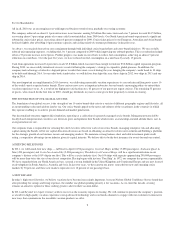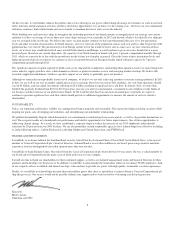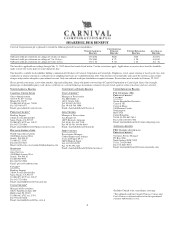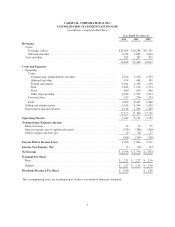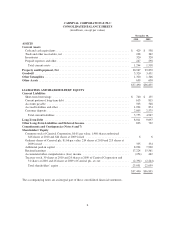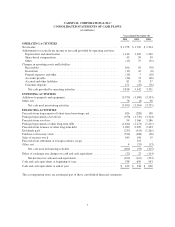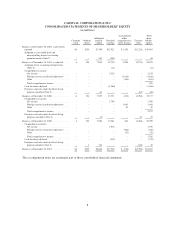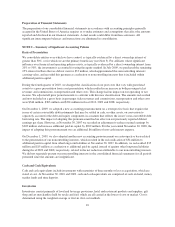Carnival Cruises 2010 Annual Report Download - page 13
Download and view the complete annual report
Please find page 13 of the 2010 Carnival Cruises annual report below. You can navigate through the pages in the report by either clicking on the pages listed below, or by using the keyword search tool below to find specific information within the annual report.Revenue and Expense Recognition
Guest cruise deposits represent unearned revenues and are initially recorded as customer deposit liabilities
generally when received. Customer deposits are subsequently recognized as cruise revenues, together with
revenues from onboard and other activities, and all associated direct costs and expenses of a voyage are
recognized as cruise costs and expenses, upon completion of voyages with durations of ten nights or less and on a
pro rata basis for voyages in excess of ten nights. The impact of recognizing these shorter duration cruise
revenues and expenses on a completed voyage basis versus on a pro rata basis is not material. Future travel
discount vouchers issued to guests are recorded as a reduction of cruise passenger ticket revenues when such
vouchers are utilized. Cancellation fees are recognized in cruise passenger ticket revenues at the time of the
cancellation.
Our sale to guests of air and other transportation to and from our ships and the related cost of purchasing this
service are recorded as cruise passenger ticket revenues and cruise transportation costs, respectively. The
proceeds that we collect from the sale of third party shore excursions and on behalf of onboard concessionaires,
net of the amounts remitted to them, are recorded as concession revenues, on a net basis, in onboard and other
cruise revenues. These amounts are recognized on a completed voyage or pro rata basis as discussed above.
Cruise passenger ticket revenues include port charges collected from our guests that vary with guest head counts.
As previously discussed, these same amounts are also expensed within commissions, transportation and other
costs in the accompanying Consolidated Statements of Income when the corresponding revenues are recognized.
Revenues and expenses from our tour and travel services are recognized at the time the services are performed or
expenses are incurred. Revenues from the leasing of our owned ships to unaffiliated parties are recognized
ratably over the term of the charter agreement using the straight-line method.
Insurance and Self-Insurance
We use a combination of insurance and self-insurance to address a number of risks including, among others,
injuries related to crew and guests, hull and machinery, war risk, workers’ compensation, employee health,
property damage and general liability. Liabilities associated with certain of these risks, principally crew medical
and crew and guest injury claims, are estimated actuarially based on historical claims experience, loss
development factors and other assumptions. While we believe the estimated loss amounts accrued are adequate,
the ultimate loss may differ from the amounts provided.
Selling and Administrative Expenses
Selling expenses include a broad range of advertising, such as marketing and promotional expenses. Advertising
is charged to expense as incurred, except for media production costs. Media production costs are recorded as
prepaid expenses and charged to expense upon the first airing of the advertisement. Advertising expenses totaled
$507 million, $508 million and $524 million in fiscal 2010, 2009 and 2008, respectively. Administrative
expenses represent the costs of our shoreside ship support, reservations and other administrative functions, and
include salaries and related benefits, professional fees and occupancy costs, which are typically expensed as
incurred.
Foreign Currency Translations and Transactions
We translate the assets and liabilities of our foreign operations that have functional currencies other than the U.S.
dollar at exchange rates in effect at the balance sheet date. Revenues and expenses of these foreign operations are
translated at weighted-average exchange rates for the reporting period. Their equity is translated at historical
rates and the resulting cumulative foreign currency translation adjustments are included as a component of
accumulated other comprehensive income (“AOCI”). Therefore, the U.S. dollar value of these non-equity
12


